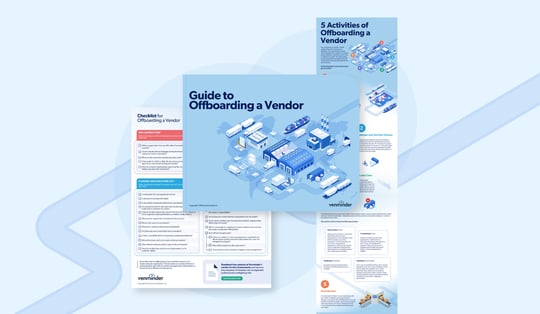Vendor Offboarding: How to Prevent Common Challenges
By: Venminder Experts on November 20 2024
6 min read

Selecting and onboarding a new vendor can involve a significant investment of time and resources. While there's typically excitement around implementing new products or services, it's important to recognize that vendor relationships don’t last forever. Sometimes, because the vendor's performance has declined, the product or service may no longer be necessary, or you find another vendor who can provide the product or service at a better price.
When it's time to part ways, having a well-structured third-party vendor offboarding process is crucial. Without one, vendor offboarding can present challenges and expose your organization to additional risks. This blog will discuss four common difficulties in vendor offboarding and provide tips on how to avoid them.
5 Potential Vendor Offboarding Process Challenges
Breaking up with a vendor can be uncomfortable, especially when dealing with challenges that hinder a smooth transition. These challenges may include the return or destruction of sensitive data, transitioning to a new vendor, and ensuring minimal disruption to ongoing operations.
Unless you have an effective vendor offboarding process, here are five common challenges you may encounter when offboarding a vendor:
- High termination costs – Most people can probably relate to the frustration of trying to end a contract for a service they no longer want or need, only to discover hefty termination fees or other unplanned expenses. In the third-party vendor offboarding process, it's essential to carefully consider termination fees and any conversion or deconversion costs that may apply.
- Ownership disputes – If a vendor has been assigned to carry out various operational processes and procedures, they may assert ownership of those processes, work product, documented procedures, or even intellectual property upon contract termination.
- Premature work stoppage – Before informing a vendor that you’ll be terminating the relationship, it's important to be prepared for the possibility that the work may stop before the agreed-upon date. This means that products or services you have relied on for an extended period of time may be cut off prematurely.
- Unsuitable replacement options – Even if you’ve chosen to stop working with the vendor due to performance issues, your organization should consider that finding a new vendor may not be a straightforward process. You might find that alternative vendors aren’t suitable for your needs, their pricing is significantly higher, or there are limited options available in the market.
- Data security and access – Remember that during the vendor offboarding process, without careful planning, cybersecurity and privacy risks can persist even after the relationship has ended. This can happen when your organization's and customers' data isn’t deleted or returned or when you fail to revoke the vendor's access to your network, systems, or facilities.
Effective Third-Party Vendor Offboarding Processes
As the old saying goes, "An ounce of prevention is worth a pound of cure." The best strategy to address vendor offboarding challenges is to prevent them from occurring in the first place. A comprehensive third-party vendor offboarding process can help protect your organization and its customers before a vendor relationship begins.
Effective vendor offboarding processes incorporate the following elements:
- Solid contract language – Even before you officially welcome the vendor into your organization, ensure your contract includes clear and appropriate language so both parties understand and accept their rights, roles, and responsibilities in the event of an exit.
- A specific and actionable exit strategy – Establishing a specific and actionable exit strategy is essential, especially for critical and high-risk vendors. An exit strategy will define what your organization will do if it needs to end the vendor relationship. Your exit strategy should be reviewed annually to ensure it’s still viable. Here are the four common exit strategies in the vendor offboarding process:
- Alternate – Replace the vendor with another
- Absorb – Bring the activity in-house
- Discontinue – End the activity altogether
- A combination – Some combination of all three methods
- A well-documented exit plan – In addition to an exit strategy, all critical and high-risk vendor engagements should have an accompanying documented exit plan. While an exit strategy outlines what you will do in the event of a vendor exit, an exit plan details how you will do it. Exit plans should include the tasks, roles, responsibilities, timing, contingency plans, and budget related to the vendor offboarding process to ensure a safe and sound exit without operational disruptions. A solid draft of the exit plan should be stored with the vendor record and reviewed at least annually to ensure the information (such as stakeholder names and contact information) is still accurate or to address any potential changes that might be necessary. Before terminating a vendor, the exit plan should be reviewed again, updated if necessary, and finalized.
- Written notification of termination – After verbally informing the third-party vendor that the relationship is being terminated, you should also send a written notification within the specified time frame stated in the contract. The written notification should be sent to the correct parties and that you can confirm its receipt through certified mail or other reliable methods.
- Constant communication – It's important to maintain open communication with your vendor to ensure a smooth and professional third-party offboarding process. Ending a vendor contract can be uncomfortable but clear communication between both parties is crucial to make the situation less challenging.
Steps to a Successful Vendor Offboarding Process
Establishing a standard vendor offboarding process at your organization can help prevent any challenges that may come up.
Here are 6 steps to successfully offboard a third-party vendor:
- Review the contract – You should understand the legal requirements surrounding termination in the third-party vendor contract before initiating the vendor offboarding process. Review the termination provisions, required notification period, additional costs or fees, and any necessary service levels.
- Make the decision to terminate – Before starting the offboarding process, have discussions with stakeholders about the decision. Consider the decision carefully and confirm if vendor offboarding is necessary. Think about whether your organization has taken all possible steps to resolve any issues with the vendor relationship. You may need to gather evidence to demonstrate that service level agreements (SLAs) weren’t met or there was a decrease in key performance indicators (KPIs). Keep documented records of discussions regarding vendor performance.
- Review continuing service requirements – When developing your vendor exit plan, it's essential to clearly define your organization's requirements for ongoing services as the relationship comes to an end. For example, the plan should specify the level of performance that the vendor must maintain throughout the offboarding process. This can include details such as timelines, deliverables, and communication protocols to ensure a smooth transition.
- Maintain data security and privacy – It’s important to make sure that data is kept secure and protected when offboarding third-party vendors. This includes securing the transfer of any organizational or customer data, as well as any other digital assets. It's also important to agree on a method of data destruction with the vendor and receive assurance that the vendor has destroyed or removed sensitive information from their systems. It's also important to determine when vendor access to your networks, systems, and facilities should be removed and validate it has been done.
- Execute the exit plan – When offboarding a vendor, it's important to discuss the exit plan with them and provide detailed documentation outlining tasks, activities, roles, responsibilities, and timing. This will help manage expectations with the vendor. Additionally, it's crucial to keep management and other stakeholders updated on the progress of the plan.
- Perform final closure activities – This may seem like a minor activity, but it's actually a key piece of the vendor offboarding process. Review and pay any final invoices, update the vendor's status in all systems (like accounts payable, procurement, and systems access), and organize and properly store relevant vendor documentation. Don't forget to update your vendor inventory.
When it comes to offboarding vendors, it can be a complex process. However, by proactively addressing potential issues and planning ahead, you can minimize unnecessary complications and costs. By anticipating and effectively managing vendor offboarding challenges in advance, you can ensure a well-prepared strategy to facilitate a smooth and efficient vendor offboarding process when the time comes.
Related Posts
6 Items to Negotiate Into Your Vendor Contracts
Learning how to successfully negotiate a vendor contract is a valuable skill to include in your...
5 Vendor Exit Strategy Considerations
There’s a lot to consider when you decide to partner with a third-party vendor, but one critical...
What Is Vendor Risk Management?
Vendor risk management (VRM) is a practice that identifies, mitigates, and manages the threats...
Subscribe to Venminder
Get expert insights straight to your inbox.
Ready to Get Started?
Schedule a personalized solution demonstration to see if Venminder is a fit for you.

















